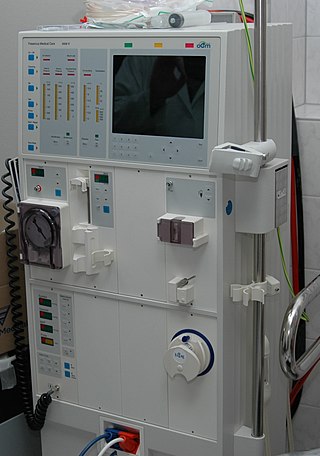Related Research Articles

Creatinine is a breakdown product of creatine phosphate from muscle and protein metabolism. It is released at a constant rate by the body.

Vancomycin is a glycopeptide antibiotic medication used to treat a number of bacterial infections. It is used intravenously as a treatment for complicated skin infections, bloodstream infections, endocarditis, bone and joint infections, and meningitis caused by methicillin-resistant Staphylococcus aureus. Blood levels may be measured to determine the correct dose. Vancomycin is also taken orally as a treatment for severe Clostridium difficile colitis. When taken orally it is poorly absorbed.

Kidney failure, also known as end-stage kidney disease, is a medical condition in which the kidneys can no longer adequately filter waste products from the blood, functioning at less than 15% of normal levels. Kidney failure is classified as either acute kidney failure, which develops rapidly and may resolve; and chronic kidney failure, which develops slowly and can often be irreversible. Symptoms may include leg swelling, feeling tired, vomiting, loss of appetite, and confusion. Complications of acute and chronic failure include uremia, hyperkalaemia, and volume overload. Complications of chronic failure also include heart disease, high blood pressure, and anaemia.

Uremia is the term for high levels of urea in the blood. Urea is one of the primary components of urine. It can be defined as an excess in the blood of amino acid and protein metabolism end products, such as urea and creatinine, which would be normally excreted in the urine. Uremic syndrome can be defined as the terminal clinical manifestation of kidney failure. It is the signs, symptoms and results from laboratory tests which result from inadequate excretory, regulatory, and endocrine function of the kidneys. Both uremia and uremic syndrome have been used interchangeably to denote a very high plasma urea concentration that is the result of renal failure. The former denotation will be used for the rest of the article.

Furosemide is a loop diuretic medication used to treat edema due to heart failure, liver scarring, or kidney disease. It had many trade names including Discoid, Frusemide, Lasix and Uremide. Furosemide may also be used for the treatment of high blood pressure. It can be taken intravenously or orally. When given intravenously, furosemide typically takes effect within five minutes; when taken orally, it typically metabolizes within an hour.

Renal functions include maintaining an acid–base balance; regulating fluid balance; regulating sodium, potassium, and other electrolytes; clearing toxins; absorption of glucose, amino acids, and other small molecules; regulation of blood pressure; production of various hormones, such as erythropoietin; and activation of vitamin D.

Acute kidney injury (AKI), previously called acute renal failure (ARF), is a sudden decrease in kidney function that develops within 7 days, as shown by an increase in serum creatinine or a decrease in urine output, or both.

Chronic kidney disease (CKD) is a type of kidney disease in which a gradual loss of kidney function occurs over a period of months to years. Initially generally no symptoms are seen, but later symptoms may include leg swelling, feeling tired, vomiting, loss of appetite, and confusion. Complications can relate to hormonal dysfunction of the kidneys and include high blood pressure, bone disease, and anemia. Additionally CKD patients have markedly increased cardiovascular complications with increased risks of death and hospitalization.

Loop diuretics are diuretics that act on the Na-K-Cl cotransporter along the thick ascending limb of the loop of Henle in nephrons of the kidneys. They are primarily used in medicine to treat hypertension and edema often due to congestive heart failure or chronic kidney disease. While thiazide diuretics are more effective in patients with normal kidney function, loop diuretics are more effective in patients with impaired kidney function.
Nephrotoxicity is toxicity in the kidneys. It is a poisonous effect of some substances, both toxic chemicals and medications, on kidney function. There are various forms, and some drugs may affect kidney function in more than one way. Nephrotoxins are substances displaying nephrotoxicity.

Hepatorenal syndrome is a life-threatening medical condition that consists of rapid deterioration in kidney function in individuals with cirrhosis or fulminant liver failure. HRS is usually fatal unless a liver transplant is performed, although various treatments, such as dialysis, can prevent advancement of the condition.

Docetaxel, sold under the brand name Taxotere among others, is a chemotherapy medication used to treat a number of types of cancer. This includes breast cancer, head and neck cancer, stomach cancer, prostate cancer and non-small-cell lung cancer. It may be used by itself or along with other chemotherapy medication. It is given by slow injection into a vein.

Piperacillin is a broad-spectrum β-lactam antibiotic of the ureidopenicillin class. The chemical structure of piperacillin and other ureidopenicillins incorporates a polar side chain that enhances penetration into Gram-negative bacteria and reduces susceptibility to cleavage by Gram-negative beta lactamase enzymes. These properties confer activity against the important hospital pathogen Pseudomonas aeruginosa. Thus piperacillin is sometimes referred to as an "anti-pseudomonal penicillin".
In pharmacology, clearance is a pharmacokinetic measurement of the volume of plasma from which a substance is completely removed per unit time. Usually, clearance is measured in L/h or mL/min. The quantity reflects the rate of drug elimination divided by plasma concentration. Excretion, on the other hand, is a measurement of the amount of a substance removed from the body per unit time. While clearance and excretion of a substance are related, they are not the same thing. The concept of clearance was described by Thomas Addis, a graduate of the University of Edinburgh Medical School.
Contrast-induced nephropathy (CIN) is a purported form of kidney damage in which there has been recent exposure to medical imaging contrast material without another clear cause for the acute kidney injury.

Acecainide is an antiarrhythmic drug. Chemically, it is the N-acetylated metabolite of procainamide. It is a Class III antiarrhythmic agent, whereas procainamide is a Class Ia antiarrhythmic drug. It is only partially as active as procainamide; when checking levels, both must be included in the final calculation.

Cystatin C or cystatin 3, a protein encoded by the CST3 gene, is mainly used as a biomarker of kidney function. Recently, it has been studied for its role in predicting new-onset or deteriorating cardiovascular disease. It also seems to play a role in brain disorders involving amyloid, such as Alzheimer's disease. In humans, all cells with a nucleus produce cystatin C as a chain of 120 amino acids. It is found in virtually all tissues and body fluids. It is a potent inhibitor of lysosomal proteinases and probably one of the most important extracellular inhibitors of cysteine proteases. Cystatin C belongs to the type 2 cystatin gene family.

Cephaloridine is a first-generation semisynthetic derivative of antibiotic cephalosporin C. It is a Beta lactam antibiotic, like penicillin. Its chemical structure contains 3 cephems, 4 carboxyl groups and three pyridinium methyl groups.

Voclosporin, sold under the brand name Lupkynis, is a calcineurin inhibitor used as an immunosuppressant medication for the treatment of lupus nephritis. It is an analog of ciclosporin that has enhanced action against calcineurin and greater metabolic stability.
Renal angina is a clinical methodology to risk stratify patients for the development of persistent and severe acute kidney injury (AKI). The composite of risk factors and early signs of injury for AKI, renal angina is used as a clinical adjunct to help optimize the use of novel AKI biomarker testing. The term angina from Latin and from the Greek ankhone ("strangling") are utilized in the context of AKI to denote the development of injury and the choking off of kidney function. Unlike angina pectoris, commonly caused due to ischemia of the heart muscle secondary to coronary artery occlusion or vasospasm, renal angina carries no obvious physical symptomatology. Renal angina was derived as a conceptual framework to identify evolving AKI. Like acute coronary syndrome which precedes or is a sign of a heart attack, renal angina is used as a herald sign for a kidney attack. Detection of renal angina is performed by calculating the renal angina index.
References
- 1 2 3 4 Udy, Andrew A.; Roberts, Jason A.; Boots, Robert J.; Paterson, David L.; Lipman, Jeffrey (January 2010). "Augmented Renal Clearance: Implications for Antibacterial Dosing in the Critically Ill". Clinical Pharmacokinetics. 49 (1): 1–16. doi: 10.2165/11318140-000000000-00000 . PMID 20000886. S2CID 41595499.
- ↑ Cockcroft, Donald W.; Gault, Henry (1976). "Prediction of Creatinine Clearance from Serum Creatinine". Nephron. 16 (1): 31–41. doi:10.1159/000180580. PMID 1244564.
- 1 2 Cook, Aaron M.; Hatton‐Kolpek, Jimmi (March 2019). "Augmented Renal Clearance". Pharmacotherapy: The Journal of Human Pharmacology and Drug Therapy. 39 (3): 346–354. doi:10.1002/phar.2231. PMID 30723936. S2CID 73441602.
- 1 2 3 4 5 Atkinson, Arthur J. (2018). "Augmented renal clearance". Translational and Clinical Pharmacology. 26 (3): 111–114. doi: 10.12793/tcp.2018.26.3.111 . PMC 6989233 . PMID 32055559.
- ↑ Shannon, James A.; Jolliffe, Norman; Smith, Homer W. (31 August 1932). "THE EXCRETION OF URINE IN THE DOG: IV. The Effect of Maintenance Diet, Feeding, etc., Upon the Quantity of Glomerular Filtrate". American Journal of Physiology. Legacy Content. 101 (4): 625–638. doi:10.1152/ajplegacy.1932.101.4.625.
- 1 2 Izumisawa, Tomohiro; Kaneko, Tomoyoshi; Soma, Masakazu; Imai, Masahiko; Wakui, Nobuyuki; Hasegawa, Hideo; Horino, Tetsuya; Takahashi, Noriko (1 December 2019). "Augmented Renal Clearance of Vancomycin in Hematologic Malignancy Patients". Biological and Pharmaceutical Bulletin. 42 (12): 2089–2094. doi: 10.1248/bpb.b19-00652 . PMID 31534058.
- 1 2 3 Saito, Kazuki; Kamio, Satomi; Ito, Kanako; Suzuki, Norifumi; Abe, Kensuke; Goto, Tatsuya (4 June 2020). "A simple scoring method to predict augmented renal clearance in haematologic malignancies". Journal of Clinical Pharmacy and Therapeutics. 45 (5): 1120–1126. doi: 10.1111/jcpt.13193 . PMID 32497262. S2CID 219327146.
- 1 2 3 Nei, Andrea M.; Kashani, Kianoush B.; Dierkhising, Ross; Barreto, Erin F. (2020). "Predictors of Augmented Renal Clearance in a Heterogeneous ICU Population as Defined by Creatinine and Cystatin C". Nephron. 144 (7): 313–320. doi: 10.1159/000507255 . PMC 7371523 . PMID 32428906.
- ↑ Spencer, Dustin D; Jacobi, Judith; Juenke, Joetta M; Fleck, James D; Kays, Michael B (October 2011). "Steady-State Pharmacokinetics of Intravenous Levetiracetam in Neurocritical Care Patients". Pharmacotherapy. 31 (10): 934–941. doi:10.1592/phco.31.10.934. PMID 21950640. S2CID 12186689.